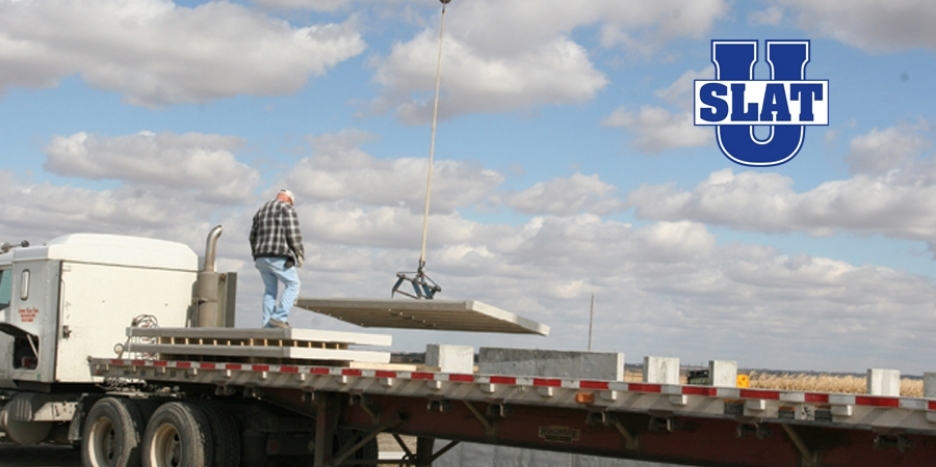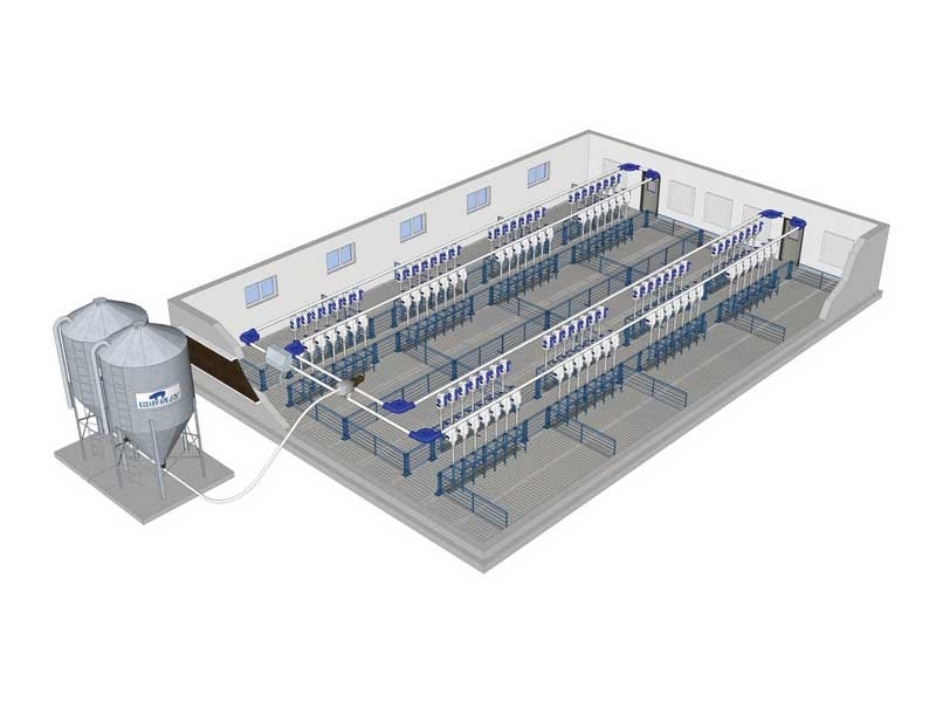Follow these guidelines when slats are delivered and set on your next building project.
Blog posts tagged with 'slats'
The size of individual sow farms continues to increase; just a few years ago 2,400 head units were considered large, but new sow farms under construction this year range between 5,000 to 14,000 head in size.
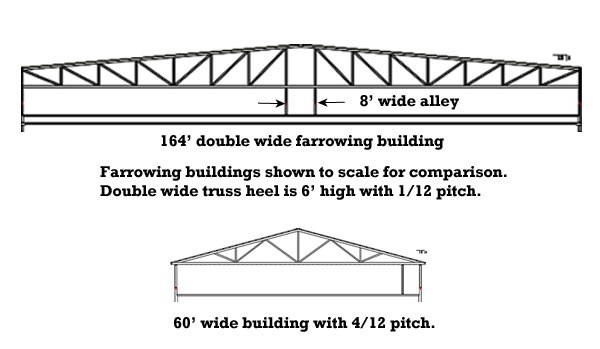
Building cross-section comparison
Designing the central production facility into two or three larger buildings has many advantages including smaller land requirements, less underground utilities to bring to the site, shorter roadways to build and maintain, fewer walkways between buildings and less linear footage of exterior building walls.
Because of increased pig capacities and the desire to minimize the number of buildings, it was necessary to increase the buildings widths up to 190 feet. Instead of the 4/12-pitch roof used on standard farm buildings, these jumbo-wide facilities utilize a two-piece rafter with a 1/12-pitch roof line resting on a center support wall in the middle. Almost 6 feet high at the heel with a center height of 13 feet, the rafters are designed more like a large floor joist. The outside appearance resembles a steel frame building more than conventional wood framed structures.
Breeding/ Gestation

Galvanized gestation stalls
Totally slatted flooring is a common feature of newly constructed B&G buildings. While past layouts consisted of a solid laying area with slat sections in the rear of the pen or stall only, new construction plans incorporate slats over the entire floor with stainless feeding troughs fastened in place. This arrangement allows long-term flexibility to reconfigure the pen layout in the future if needed.
Group housing with stanchions is the predominant type of housing under construction this year. Largely through trial and error, the industry seems to have settled into pen configurations containing eight to twelve sows. This pen size permits closer grouping by size and condition and promotes easier visual inspection.
Whether the production system chooses gestation stalls, stanchions, or ESF, most equipment is specified with hot-dipped galvanized equipment instead of painted finish. The extended equipment life provided by the galvanized finish makes this an economical business decision.
One advantage reported with stanchion systems is longer equipment life resulting from moving the water away from the front of the stanchions. Locating a cup or swinging water pipe with nipples in the center of the pen reduces the deterioration of feed pipes and stall fronts by minimizing water contact with these areas.
Farrowing

Large pen farrowing crates with SowMAX feeders
Jumbo style layouts permit designing a double farrowing building with an extra wide 8-foot center alleyway to aid in animal and people movement between rooms.
Almost every new construction project increases the length and width of the farrowing crates and creep area from the standard 5′ x 7′ footprint up to 6’ wide by 8′ long, with some systems choosing 8’6″ long crates. Longer framed sows and reduced piglet crushing rates from using wider pens have driven this trend. Again, the equipment will have a galvanized finish with a combination of cast iron, TriDek, or plastic slats for flooring choices.
Most production systems will incorporate some provision for ad-lib sow feeding. Besides reducing farm labor, ad-lib sow feeding is the most efficient method for feeding individual sows to reach full milk production potential. The type of systems can range from electronic transponder metering devices to sow activated hopper type feed dispensers.
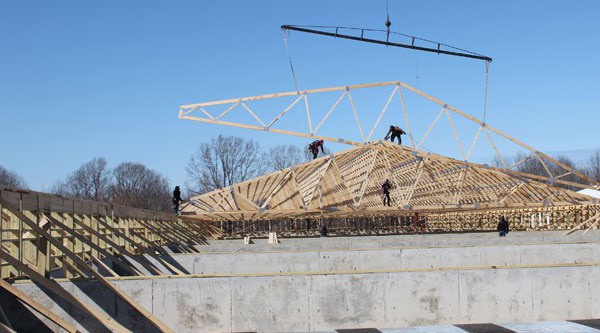
Swinging rafters on new farrowing house
Projects of this size require builders with an expanded skill set. A builder must be able to provide professional project management, understanding of regulatory issues, and increased insurance coverage. It is also critical for any construction firm undertaking projects of this size to have sufficient financial backing and the ability to manage large cash flows.
For more information about Hog Slat’s construction projects and swine production equipment offerings, contact your nearest sales representative by clicking here.
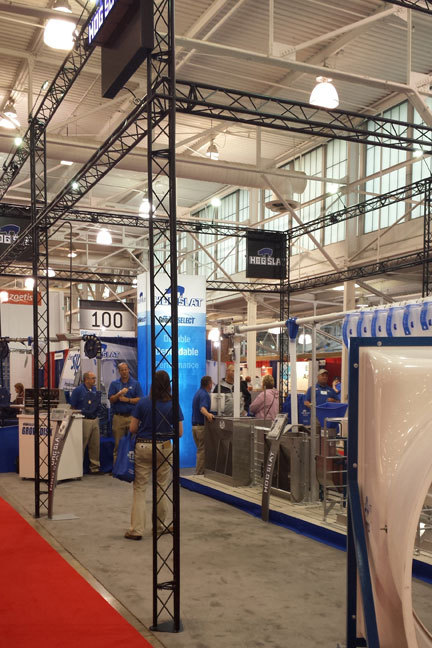
Another successful show is in the books for Hog Slat at the 2015 World Pork Expo in Des Moines, Iowa. This year, Hog Slat displayed several new items, including our AirStorm fiberglass ventilation fans, Grow-Disk™ chain disk feed system and the GrowerSELECT® curtain machine. In addition to these new products, we also featured our concrete slats, TriDek flooring, group pen feed stanchions, GrowerSELECT sow drops and more.
Hog Slat hosted a group of Chinese pig farmers that were visiting the United States and attended the World Pork Expo. On Tuesday, as part of their trip, we visited a brand new 2 barn finishing site Hog Slat just completed, located in Lohrville, IA. The group was able to see a new group of pigs that had just been loaded into one of the barns earlier that afternoon, and also examine the inside of the other barn that had not been loaded with pigs yet.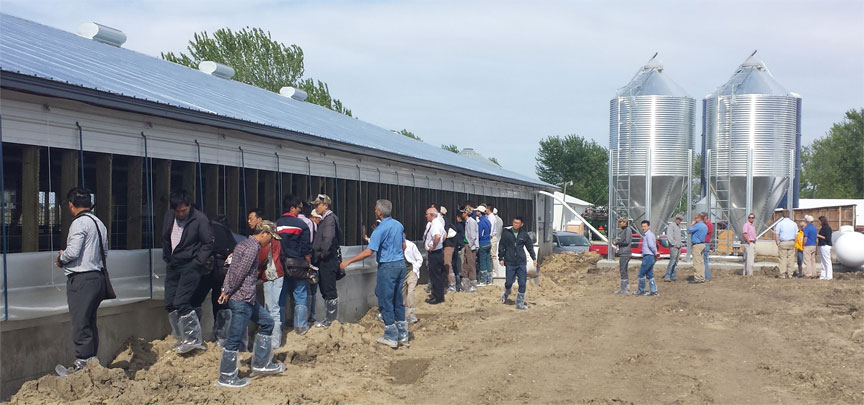
Both of these deep pit barns were equipped with GrowerSELECT Grow-Flex™ feed systems, Hog Slat wet/dry hog feeders and AquaChief cup waterers as part of their equipment package. The group was very impressed with the fit and finish of Hog Slat’s feed system equipment and building construction. To learn more about new construction or remodeling hog barns in the Midwest or other areas of the United States, please visit the Hog Slat sales representative locator, found here.
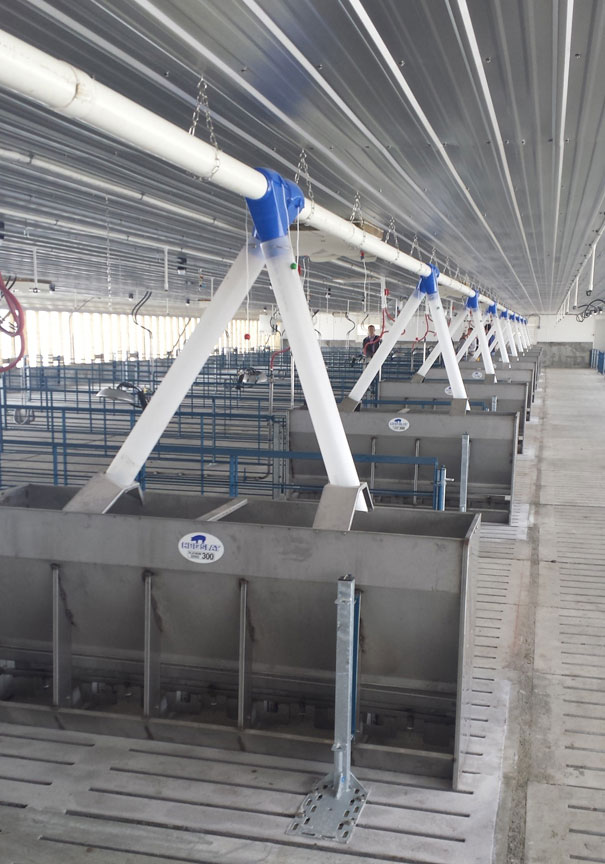
Hog Slat will be exhibiting at this year’s World Pork Expo with many new and further developed swine equipment products, highlighting Hog Slat’s GrowerSELECT product line.
At the show, Hog Slat will have a large variety of equipment on display in both the exhibition hall (Booth V165 VIB) and at the Hog Slat hospitality tent (Tent G234). Equipment that will be on display includes Hog Slat’s Grow-Flex Feed System, Grow-Disk Feed System, Slats, and an introduction to Hog Slat’s AirStorm fans. We invite you to stop by the Hog Slat booth to see what’s new at the show.
Enjoy FREE ADMISSION to the 2015 World Pork Expo, courtesy of Hog Slat. You may redeem your admission voucher by registering online at www.worldpork.org by May 28th and use voucher code HogSlat2015. Or, present a hard copy of our voucher (available through the Hog Biz, local Hog Slat retail stores, or your local sales contact) during on-site registration the day of the expo. Expo registration is located in the Animal Learning Center inside Gate 15.
Craving some good BBQ? Stop by the Hog Slat hospitality tent anytime during expo to enjoy Vinny’s BBQ, located in Dakota City, IA. Vinny’s will be serving lunch and dinner both Wednesday and Thursday of the expo.
The World Pork Expo is held June 3rd-5th in Des Moines, IA at the Iowa State Fairgrounds. Visit us at the show in booth V165 in the Varied Industries Building and Hospitality Tent G234. We hope to see you at the show!
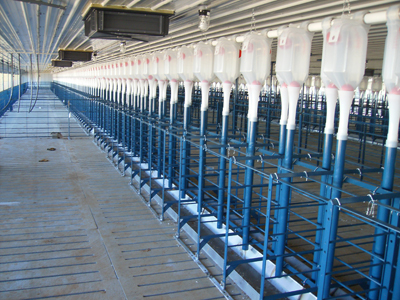 As the swine industry searches for alternatives to stall gestation, another option has emerged and is in the process of being refined. Stanchion Housing refers to short stall-like dividers that are added to open pen gestation to separate and protect the animals as they are fed. It is a refinement over traditional open pens where sow are fed on the floor and group size must be limited to reduce fighting.
As the swine industry searches for alternatives to stall gestation, another option has emerged and is in the process of being refined. Stanchion Housing refers to short stall-like dividers that are added to open pen gestation to separate and protect the animals as they are fed. It is a refinement over traditional open pens where sow are fed on the floor and group size must be limited to reduce fighting.
To date all the systems have been designed with standard gestation stalls in which the sows are weaned and remain until they are bred and preg checked. Typically this would be about a 45 day inventory of the total sow numbers.
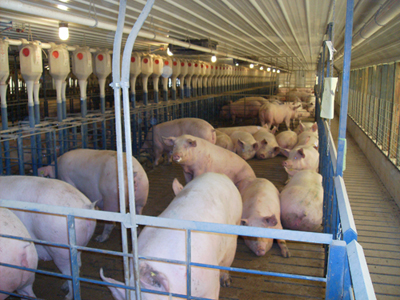 Looking at the total number of animals in a breeding group, a decision can be made on total numbers of sows per pen. Current stanchion systems range from 10 head per pen all the way up to over a hundred. Many producers choose to break a farrowing group into two or three different pens as this allows for grading and sorting weaned animals by body score. Placing sows in similar groups reduces fighting and allows for uniform feeding.
Looking at the total number of animals in a breeding group, a decision can be made on total numbers of sows per pen. Current stanchion systems range from 10 head per pen all the way up to over a hundred. Many producers choose to break a farrowing group into two or three different pens as this allows for grading and sorting weaned animals by body score. Placing sows in similar groups reduces fighting and allows for uniform feeding.
After total number of sows per pen is determined, the next design consideration is the amount of square footage per animal. Current EU welfare regulations require 24 sq ft. and some producers have chosen to follow that guideline, but systems exist that range from this level all the way down to 17 sq ft./sow.
Two critical design elements have proved themselves in the existing layouts. 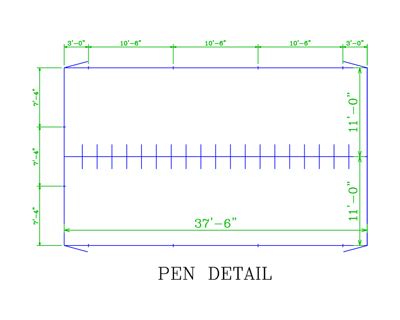 First, long narrow pens are preferred as this prevents a boss sow from blocking feed stanchions. The second design feature is placing the stanchions head to head in the center of the pen rather than placing them along the alleys. Because the stanchions are not in the alleys, the sows can be viewed from the rear during feeding for problems. It also allows for easier animal movement in and out of the pens as the gates are not part of the stanchions. In addition, the number of feed lines needed is reduced.
First, long narrow pens are preferred as this prevents a boss sow from blocking feed stanchions. The second design feature is placing the stanchions head to head in the center of the pen rather than placing them along the alleys. Because the stanchions are not in the alleys, the sows can be viewed from the rear during feeding for problems. It also allows for easier animal movement in and out of the pens as the gates are not part of the stanchions. In addition, the number of feed lines needed is reduced.
The first stanchion systems featured trickle feed equipment where the feed slowly dribbled in front of the sows at meal time, the idea being a slow placement of feed in front of the sows would hold them in the stalls and prevent boss sows from “wolfing down” their feed and moving up and down the line stealing feed. In practice, the additional cost and upkeep of a trickle system did not justify its use and has been omitted on new installations. Current systems use standard feed drops that dump the entire ration into stainless steel troughs or on a solid concrete floor.
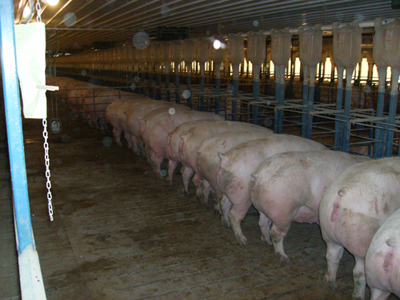 Equipment used in a head-to-head layout consists of stanchions that are 40” tall and 19” long. These dimensions protect the face and ears of the individual sow from aggressive pen mates. Ideal width has been determined to be 20” as this prevents other sows from crowding in to steal feed. Early systems used solid dividers; as we gained more experience with head-to-head systems, the use of open dividers was adopted. The Hog Slat equipment used to configure this layout is an adaption of our standard gestation stall which has been used throughout the industry for over 30 years. The stanchions are constructed of solid horizontal rods with angle top and bottom rails, the entire unit bolts together with galvanized floor spacers and double top spacers for added stability. This style of stanchion fits completely with the standard 40” gestation penning used in the rest of the pen layout. The result is a well-designed system that goes together without a great deal of “field fabrication”. AquaChief cup waterers are added at the rate of one per 11 animals to provide fresh water.
Equipment used in a head-to-head layout consists of stanchions that are 40” tall and 19” long. These dimensions protect the face and ears of the individual sow from aggressive pen mates. Ideal width has been determined to be 20” as this prevents other sows from crowding in to steal feed. Early systems used solid dividers; as we gained more experience with head-to-head systems, the use of open dividers was adopted. The Hog Slat equipment used to configure this layout is an adaption of our standard gestation stall which has been used throughout the industry for over 30 years. The stanchions are constructed of solid horizontal rods with angle top and bottom rails, the entire unit bolts together with galvanized floor spacers and double top spacers for added stability. This style of stanchion fits completely with the standard 40” gestation penning used in the rest of the pen layout. The result is a well-designed system that goes together without a great deal of “field fabrication”. AquaChief cup waterers are added at the rate of one per 11 animals to provide fresh water.
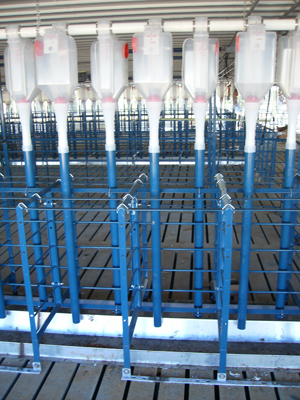 Many of the stanchion systems are remodels, the layout of which has to be adapted to existing slat /solid configurations. If building new projects most producers opt for using total slats as this allows for more flexibility in the event of changes in the welfare regulations.
Many of the stanchion systems are remodels, the layout of which has to be adapted to existing slat /solid configurations. If building new projects most producers opt for using total slats as this allows for more flexibility in the event of changes in the welfare regulations.
Stanchion systems require a high degree of stockmanship to operate successfully. Boss sows must be culled ruthlessly and individual care of animals is more difficult than standard stall systems. However, for many production systems, stanchions are a better alternative than Electronic Sow Feeding. Stanchions allow group housings of animals without the costs and high maintenance associated with ESF stations.
For more information please contact your local Hog Slat rep or contact us by email at frichards@hogslat.com.
I have sold or been involved with swine concrete slats for over 30 years. For the last 18 of those years I have represented Hog Slat products. I believe that our slats are the best in the industry and have the most consistent quality. But new slats all look good when they are getting unloaded off the delivery truck. What about when they are 5 years or 10 years or even older?
Last week I was at Hog Slat’s production plant in Humboldt, Iowa taking pictures of slats. The plant manager, Dave Shiflett said “You want to see some old slats that we pulled out of a barn recently?”
“Sure”
So we go out behind the plant and he explained that we were called in to replace some slats from local production site. This particular site was built in 1994. One barn has slats produced by Hog Slat and the other barn has slats from a competitor.

Comparing slats
He said “The slat on the left is a Hog Slat slat and the one on the right is from the competitor. Notice the difference in surface wear on each slat. The competitor’s slat has rock showing because the top surface has been eaten or worn away. I grabbed our slat out of the other building that they were not replacing for comparison.”
“Interesting, but they’re not from the same building”
“No but same site which means same water, same feed and same management. Pretty good comparison of 17 years old slats I would say”
So we started talking about the reasons for the better wear on the Hog Slat product.
Dave said “It’s the denser concrete we use in our mix. Everybody that has ever poured any concrete knows the less water you use in mixing concrete, the harder, stronger concrete you get. The standard mix is a 4” slump, which you have to use to be able to place and screed the concrete in the form. We use a ZERO SLUMP mix in our slats. Let me show you what I mean inside.”
So we go inside and Dave has slump cone in which he places some of our concrete mix and pulls the cone. He adds water to an additional batch to represent a standard 4” concrete mix.
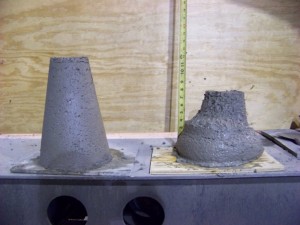
concrete slump
“Note how the concrete mix on the right has sagged down 4” vs. the zero slump concrete on the right? All the rest of the slat manufacturers have to use a wetter mixture because they don’t have equipment that allows them to work a drier mix. Like I said earlier less water means a stronger, denser concrete that wears better and holds up longer in the barns.”
As the industry’s production buildings get older this comparison bears keeping in mind. Most new slats look the same when they are placed in the barn and you really can’t tell the difference from the outside. Buying slats for a new building or replacements in an existing structure is an important decision that producers should take under careful consideration. Looking at 17 year old slats is a chance to get some valuable insight that may help with that decision.
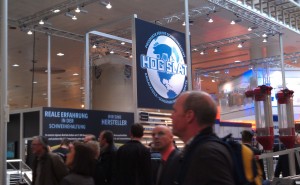 Billed as the world’s top event for animal production, EuroTier was held this past week in Hanover, Germany. Producers from across the world attend EuroTier and for many it was their first exposure to American style production equipment as exhibited by Hog Slat.
Billed as the world’s top event for animal production, EuroTier was held this past week in Hanover, Germany. Producers from across the world attend EuroTier and for many it was their first exposure to American style production equipment as exhibited by Hog Slat.
We spoke with Hog Slat’s European sales manager, Kirk Brincks and asked about international producers comments concerning the equipment. He replied, “ Their general reaction is Hog Slat builds durable products that represent a good value. They like the common sense design and how it is incorporated into the overall building layout.”
We asked Kirk what particular item was most popular, “ I would have to say the SowMAX dispensers. All producers are facing high feed costs and feed saving equipment is important to them. A customer, with sow farms in the Ukraine and Poland, has installed over 1,000 SowMAX units and is sold on the feed savings.”
He continued, “Another big item of interest is concrete slats. We had many producers who see them for the first time and immediately comment on the quality. I think people tend to view concrete slats as all being kind of the same, but we really do build a slat that will last longer. Experienced producers seemed to recognize it very quickly.”
“And”, he laughed, “they always ask when are we building a slat plant near them”
Kirk finished up with, “The Grower Select line has caught on quickly. We have several production companies that we work with in identifying their high replacement items, providing them easy order forms and stocking those parts for quick delivery. Grower Select just fits with Hog Slat’s basic philosophy of providing producers with a better value for their money……. in this case it’s excellent quality replacement parts that are priced right.”
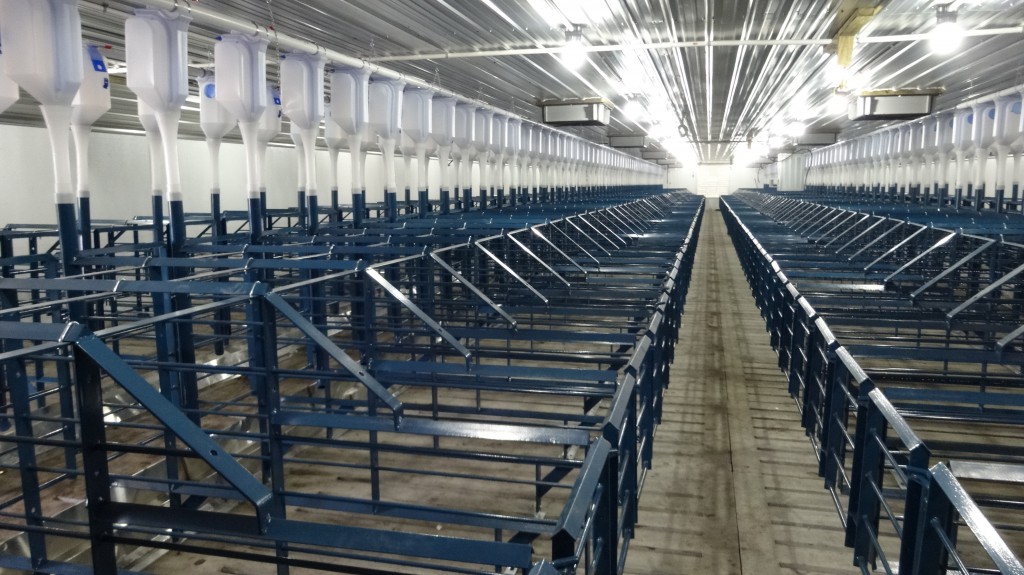
Take a quick video tour of a recently completed swine gestation building located near Hardy, IA. This 41′ X 133′ gestation building houses 260 animals.
The building features a GrowerSELECT® Evap system, GrowerSELECT flag feed system with individual Sow Drops, Hog Slat dry cast slats, Hog Slat gestation stalls and a tunnel ventilation system.
- 2025
- 2024
- 2023
- 2022
- 2021
- 2020
- 2019
- 2018
- 2017
- 2016
- 2015
- 2013












 Україна
Україна Méjico
Méjico